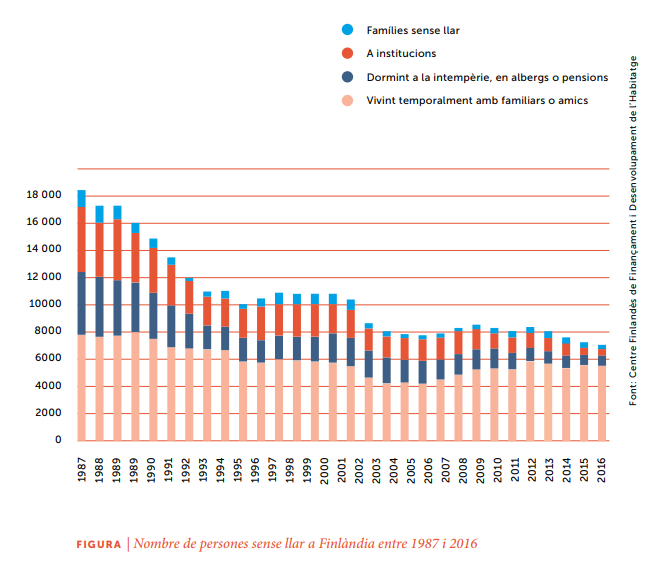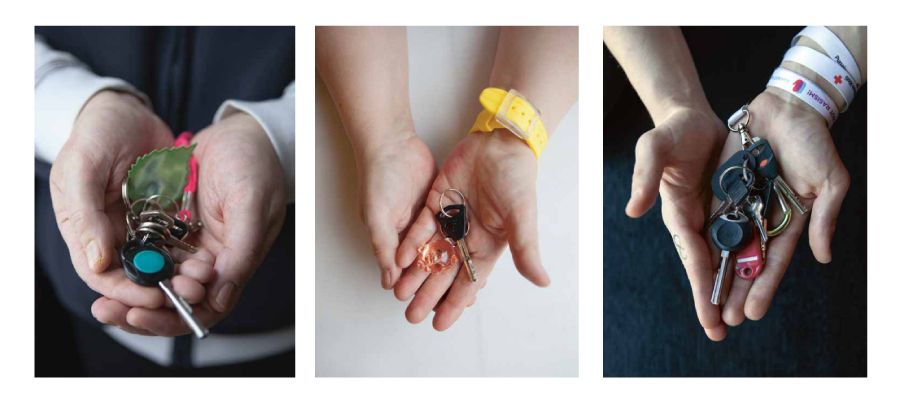Finland has reduced homelessness by 35% between 2008 and 2015 thanks to joint work at local and state level and a dedicated commitment to the Housing First model. Their idea is as simple as it is radical: to give people who have lost their homes a permanent home and all the support they need. And the idea works: Finland is the only country in Europe where the number of homeless people is decreasing year after year.
La teva pròpia llar. The Housing First model and the eradication of senselessness in Finland describes this model in detail. This book, published by the Y-Foundation i traduït al català per Arrels Foundationis a manual that sets out the foundations of the Finnish model, which can serve as a guide to guide housing policies at home, and which we have translated into Catalan. It is aThis is a tool at the disposal of public administrations, social entities and society as a whole to show that it is possible to tackle the problem of homelessness and that the best way is to do so with decent and stable housing as a starting point. You can download for free here.
What is Housing First?
Housing First is a philosophy of eradicating senselessness that was born in the United States in the 1990s, and which sees access to housing as the starting point from which a homeless person begins to rebuild their life. The model approaches care for people without a home in a broader sense, recognising and taking into account the different life trajectories that can lead to the situation of not having a home. It aims to start living in a home from the beginning, offering social support to the person and is in contrast to the scale model, in which a homeless person has to go through different types of temporary accommodation and comply with certain regulations as a precondition to reach the allocation of a home.

According to the Housing First model, housing should not be the prize that awaits a person without a home if they manage to refer their life but rather the base from which they will try to refer it. Its policy is based on the idea of giving people who have been left without a home a permanent home, as well as all the necessary support with the home as a starting point. It is understood that a home provides independence, and that once a person is guaranteed the stability that a home provides, they can face the rest of the challenges, such as recovering their health, addictions, trauma or rebuilding their social network. On this basis, the support services are organised in such a way that they respect the autonomy of the resident, encouraging their participation in the process.
In Housing First -following the example of Finland-, support services have had to be reformulated so that dialogue and peer-to-peer interaction are the ways to find joint solutions to the problems of each person concerned. Finally, great importance is given to community life, in the understanding that the feeling of belonging to an environment and a group of people can help a lot in the return to a satisfactory life.
The transition to the new model
1,325 people were no longer considered homeless. From 2016, the model was exported to the whole country with the Action Plan to Prevent Homelessness in Finland, known as AUNE (2016 - 2019). Between 2015 and 2019, the reduction will continue along the same lines with a further 32% decrease.
The transition to Housing First has required a great state pact that all governments since then have respected, maintaining support for the same principle regardless of political colour. Councils, organisations and experienced experts - people who have personally experienced one form or another of homelessness - have been key players in this model of cooperative work.
The aim of the translation of this manual is that it becomes a reference tool for municipalities and organisations in our country, and that Housing First becomes the model for eradicating senselessness in a structural way throughout the territory.
Today there are practically no temporary accommodation shelters left in Finland. A good example is the capital city: of the 558 places that existed in Helsinki in 2008, in 2017 there were only 56 left to deal with emergency situations. In contrast, the number of sheltered housing units went from 552 to 1,309 in the same period. Now the housing units -some with support services- are the main way for a person to leave homelessness behind.

La teva pròpia llar: El llibre com a marc referencial
The publication A home of your own takes a look at the history of Housing First, its fundamental principles, aspects of implementation on a practical scale and shares various testimonies, as well as data and references to understand the keys to the success of a model that is expanding. The aim of the translation of this manual is that it becomes a reference tool for municipalities and organisations in our country, and that Housing First becomes the model for eradicating senselessness in a structural way throughout the territory.
La teva pròpia llar collects various testimonies that have benefited from the programme. This is the case of this 58-year-old man who lost his flat in 2010 due to addiction and other causes:
"I now live in a 36.5 square metre studio in the Väinölä unit. It doesn't even compare to the places I've lived before. I have never felt at home in any of them. In the social services unit they imposed a routine on you: lunch, dinner, afternoon tea, dinner and supper. In the transition residences there were communal dormitories and curfews. Now that I have my own flat, I don't have to be on my toes all day. It's my home".
According to the European definition, a homeless person is any person who does not own or rent a home. In other words, in the worst cases, homeless people sleep rough, but many live temporarily with their parents or friends. This is the case of this 59-year-old woman:
"Even though I already had a support, I was officially a woman without a home. It may seem like an unimportant detail, but it was something that made my life go up in smoke. It was as if I were a second-class citizen, a social dropout. I felt guilty and I kept asking myself if I could have done things differently. Society treats people without a home in a special way. Si va al banc i pregunten la teva adreça, per exemple, la seva actitud canva per complet si els doones un apartat de correus. No em sembla just. Why stigmatise people without a home in this way, when many of them haven't been able to do anything to change their situation?"
Monapart with Arrels Fundació: no one sleeping on the street
The figures speak for themselves: there are more than 4,700 homeless people in Barcelona. 1,239 sleep on the street. During this year, the foundation has helped more than 1,400 people and provides accommodation for more than 200.
Since 1987, Arrels Foundation guides people who are on the streets about what they can do to improve their situation and explains the resources available in the city. They provide them with useful services, accommodation and social and health care to cover the basic needs of the most vulnerable people, and provide them with close accompaniment in their personal journey towards a situation that is as autonomous as possible.
La seva campanya #ningúdormintalcarrerhas been active for years and is one of the movements with the greatest media impact, and at Monapart we could not remain on the sidelines. It is an issue that affects us all. For years now, Monapart Barcelona collaborates with Arrels Foundation by donating 0.7% of its income obtained in sales transactions. We encourage you to collaborate in any way you can: becoming a volunteer, becoming a member, making a donation or simply getting involved if you find someone sleeping on the ground and informing Arrels through its website. AppLocalitzador. Tot sum!
Finland has reduced homelessness by 35% between 2008 and 2015 thanks to the Housing First model, which aims to provide homeless people with a permanent home and all the support they need. Arrels Fundació has translated into Catalan and made available to the public an essential downloadable guide to understand and apply this model.


